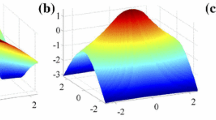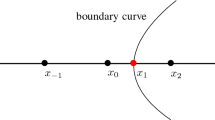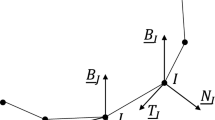Abstract
Level set methods [Osher and Sethian. Fronts propagating with curvature-dependent speed: algorithms based on Hamilton–Jacobi formulations. J. Comput. Phys. 79 (1988) 12] have proved very successful for interface tracking in many different areas of computational science. However, current level set methods are limited by a poor balance between computational efficiency and storage requirements. Tree-based methods have relatively slow access times, whereas narrow band schemes lead to very large memory footprints for high resolution interfaces. In this paper we present a level set scheme for which both computational complexity and storage requirements scale with the size of the interface. Our novel level set data structure and algorithms are fast, cache efficient and allow for a very low memory footprint when representing high resolution level sets. We use a time-dependent and interface adapting grid dubbed the “Dynamic Tubular Grid” or DT-Grid. Additionally, it has been optimized for advanced finite difference schemes currently employed in accurate level set computations. As a key feature of the DT-Grid, the associated interface propagations are not limited to any computational box and can expand freely. We present several numerical evaluations, including a level set simulation on a grid with an effective resolution of 10243
Similar content being viewed by others
References
Adalsteinsson D., and Sethian J.A. (1995). A fast level set method for propagating interfaces. J. Comput. Phys. 118(2): 269–277
Adalsteinsson D., and Sethian J.A. (1999). The fast construction of extension velocities in level set methods. J. Comput. Phys. 148:2–22
Breen, D., Fedkiw, R., Museth, K., Osher, S., Sapiro, G., and Whitaker, R. (2004). Level Sets and PDE Methods for Computer Graphics. ACM SIGGRAPH ’04 COURSE #27. ACM SIGGRAPH, Los Angeles, CA, August 2004. ISBN 1-58113-950-X.
Bridson R. (2003). Compuational Aspects of Dynamic Surfaces. Ph.D., thesis, Stanford University, Stanford California
Chan T., and Vese L. (2001). Active contours without edges. IEEE Trans. Image Process. 10:266–277
Droske, M., Meyer, B., Rumpf, M., and Schaller, C. (2001). An adaptive level set method for medical image segmentation. Lect. Notes Comput. Sci. pp. 412–422.
Enright D., Fedkiw R., Ferziger J., and Mitchell I. (2002). A hybrid particle level set method for improved interface capturing. J. Comput. Phys. 183(1):83–116
Enright D., Losasso F., and Fedkiw R. (2005). A fast and accurate semi-lagrangian particle level set method. Comput. Struct 83(6–7):479–490
Fedkiw R., Aslam T., and Xu S. (1999). The ghost fluid method for deflagration and detonation discontinuities. J. Comput. Phys. 154:393–427
Foster, N., and Fedkiw, R. (2001). Practical animation of liquids. In ACM SIGGRAPH ’01, ACM Press, pp. 23–30
Osher, S., Losasso, F., and Fedkiw, R. Spatially adaptive techniques for level set methods and incompressible flow. Comput. Fluids (in review)
Frisken S., and Perry R. (2003). Simple and efficient traversal methods for quadtrees and octrees. J. Graphics Tools 7(3):1–11
Gibou F., Fedkiw R., Caflisch R., and Osher S. (2003). A level set approach for the numerical simulation of dendritic growth. J. Sci. Comput. 19(1–3):183–199
Houston, B., Wiebe, M., and Batty, C. (2004). Rle sparse level sets. In Proceedings of the SIGGRAPH 2004 Conference on Sketches & Applications. ACM Press
Leveque R.J. (1996). High-resolution conservative algorithms for advection in incompressible flow. SIAM 33(2):627–665
Losasso, F., Gibou, F., and Fedkiw, R. (2004). Simulating water and smoke with an octree data structure. In ACM SIGGRAPH ’04, ACM Press, pp. 457–462
Liu X.D., Osher S.J., and Chan T. (1994). Weighted essentially nonoscillatory schemes. J. Comput. Phys. 115:200–212
Museth K., Breen D., Whitaker R., and Barr A. (2002). Level set surface editing operators. ACM Trans. on Graphics (Proc. SIGGRAPH) 21(3):330–338
Meyers, S. (1997). Effective C++ (2nd ed.): 50 Specific Ways to Improve Your Programs and Designs. Addison-Wesley Longman Publishing Co., Inc
Milne, R. B. (2003). An Adaptive Level Set Method. Ph.D., thesis, Berkeley National Laboratory, Physics Division, Mathematics Department
Min C. (2004). Local level set method in high dimension and codimension. J. Comput. Phys. 200:368–382
Nguyen, D., Fedkiw, R., and Jensen, H. W. (2002). Physically based modeling and animation of fire. In ACM SIGGRAPH ’02, ACM Press, pp. 721–728
Osher S.J., and Fedkiw R.P. (2002). Level Set Methods and Dynamic Implicit Surfaces. Springer, Berlin
Osher S., and Paragios N (eds). (2003). Geometric Level Set Methods in Imaging, Vision and Graphics. Springer-Verlag
Osher S., and Sethian J. (1988). Fronts propagating with curvature-dependent speed: Algorithms based on Hamilton-Jacobi formulations. J. Comput. Phys. 79:12–49
Osher S., and Shu C.W. (1991). High-order essentially nonoscillatory schemes for hamilton-jacobi equations. SIAM J. Num. Anal. 28:907–922
Peng D., Merriman B., Osher S., Zhao H., and Kang M. (1999). A pde-based fast local level set method. J. Comput. Phys. 155(2), 410–438
Rudin L., Osher S., and Fatemi E. (1992). Nonlinear total variation based noise removal algorithms. Physica D 60:259–268
Sussman M., Almgren A.S., Bell J.B., Colella P., Howell L.H., and Welcome M.L. (1999). An adaptive level set approach for incompressible two-phase flows. J. Comput. Phys. 148:81–124
Samet H. (1990). Applications of Spatial Data Structures: Computer Graphics, Image Processing, GIS. Addison-Wesley, Reading, MA
Sethian J.A. (1996). A fast marching level set method for monotonically advancing fronts. Proc. Nat. Acad. Sci. USA 93(4):1591–1595
Sethian J.A. (1999). Level Set Methods and Fast Marching Methods, Second edition. Cambridge University Press, Cambridge, UK
Stolte, N., and Kaufman, A. (1998). Parallel spatial enumeration of implicit surfaces using interval arithmetic for octree generation and its direct visualization. In Implicit Surfaces ’98, pp. 81–87
Shu C.W., and Osher S. (1988). Efficient implementation of essentially non-oscillatory shock capturing schemes. J. Comput. Phys. 77:439–471
Sussman M., Smereka P., and Osher S. (1994). A level set approach to computing solutions to incompressible two-flow. J. Comput. Phys. 114:146–159
Strain J.A. (1999). Tree methods for moving interfaces. J. Comput. Phys. 151(2):616–648
Tsitsiklis, J. N. (1994). Efficient algorithms for globally optimal trajectories. Proceedings of the 33rd Conference on Decision and Control, Lake Buena Vista, LF, pp. 1368–1373
Tsitsiklis J.N. (1995). Efficient algorithms for globally optimal trajectories. IEEE Trans. Automat. Contr. 40:1528–1538
Whitaker R.T. (1998). A level-set approach to 3d reconstruction from range data. Int. J. Comput. Vision 29(3):203–231
Westermann R., Kobbelt L., and Ertl T. (1999). Real-time exploration of regular volume data by adaptive reconstruction of isosurfaces. Visual Comput. 15(2):100–111
Zhao H., Osher S., Merrian B., and Kang M. (2000). Implicit and nonparametric shape reconstruction from unorganized data using a variational level set method. Comput. Vision Image Understand. 80:294–314
Author information
Authors and Affiliations
Corresponding author
Rights and permissions
About this article
Cite this article
Nielsen, M.B., Museth, K. Dynamic Tubular Grid: An Efficient Data Structure and Algorithms for High Resolution Level Sets. J Sci Comput 26, 261–299 (2006). https://doi.org/10.1007/s10915-005-9062-8
Received:
Accepted:
Published:
Issue Date:
DOI: https://doi.org/10.1007/s10915-005-9062-8




